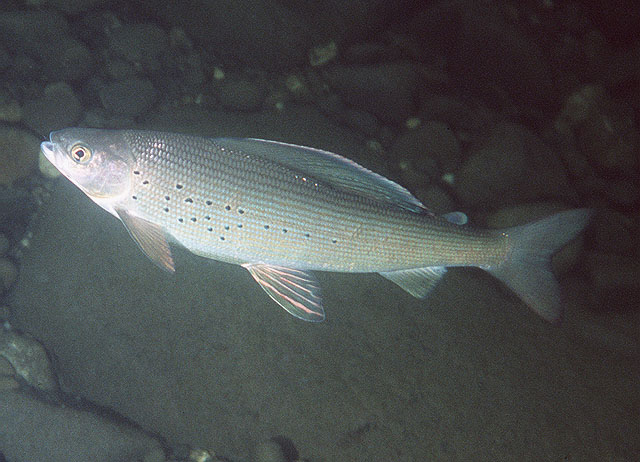| Salmonidae (Salmonids), subfamily: Thymallinae |
| 76 cm TL (male/unsexed); max.weight: 3,830.0 g; max. reported age: 18 years |
|
benthopelagic; freshwater; depth range - 30 m |
| North America: widespread in Arctic drainages from Hudson Bay, Canada to Alaska and in Arctic and Pacific drainages to central Alberta and British Columbia in Canada; upper Missouri River drainage in Montana, USA. Formerly in Great Lakes basin in Michigan, USA (Ref. 5723). Arctic Ocean basin in Siberia from Ob to Yenisei drainages and in Europe in some tributaries of Pechora (Usa, Kosyu, Kozhim), Korotaikha and Kara (Ref. 59043). |
|
Dorsal spines (total): 0-0; Dorsal soft rays (total): 17-25; Anal spines: 0-0; Anal soft rays: 11-15; Vertebrae: 58-62. Distinguished by its greatly enlarged dorsal fin and its small mouth, which has fine teeth on both jaws (Ref. 27547). Dorsal greatly enlarged in adults (especially males), reaching adipose fin when depressed, but is shorter in females; pelvic fins rather long, reach anal fin in adult males, but not in females; lower lobe of caudal often longer than upper (Ref. 27547). A strikingly colored fish, the dorsal surface is dark purple, or blue black to blue gray, the sides gray to dark blue with pinkish iridescence, the ventral surface gray to white (Ref. 1998). Scattered dark spots on sides, these being more numerous on the young; a dark longitudinal stripe along lower sides between pectoral and pelvic fins; dorsal fin dark with narrow purple edge (rows of reddish to orange or purple to green spots on body of fin); pelvic fins dark with irregular diagonal orange-yellow stripes; adipose, dorsal, anal, caudal and pectorals dusky to dark (Ref. 27547). |
| Inhabits open water of clear, cold, medium to large rivers and lakes. Enters rocky creeks to spawn (Ref. 5723). Occurs in piedmont and montane cold streams, rivers and lakes with high oxygen concentrations (Ref. 59043). Forms schools in moderate numbers (Ref. 9988). Young feed on zooplankton with a gradual shift to immature insects; adults feed mainly on surface insects but also take in fishes, fish eggs, lemmings, and planktonic crustaceans (Ref. 1998). Spawns in montane streams with heavy current on shallows with rock-gravel bottom (Ref. 59043). Utilized fresh and can be fried, broiled, boiled, and baked (Ref. 9988). |
|
Least Concern (LC); Date assessed: 01 January 2008 Ref. (130435)
|
| harmless |
Source and more info: www.fishbase.org. For personal, classroom, and other internal use only. Not for publication.
